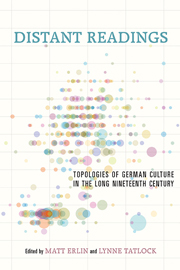Book contents
- Frontmatter
- Contents
- Acknowledgments
- Introduction: “Distant Reading” and the Historiography of Nineteenth-Century German Literature
- I Quantification
- 1 Burrows's Delta and Its Use in German Literary History
- 2 The Location of Literary History: Topic Modeling, Network Analysis, and the German Novel, 1731–1864
- 3 How to Read 22,198 Journal Articles: Studying the History of German Studies with Topic Models
- 4 Serial Individuality: Eighteenth-Century Case Study Collections and Nineteenth-Century Archival Fiction
- 5 The Case for Close Reading after the Descriptive Turn
- II Circulation
- III Contextualization
- Selected Bibliography
- Contributors
- Index
1 - Burrows's Delta and Its Use in German Literary History
from I - Quantification
Published online by Cambridge University Press: 05 April 2014
- Frontmatter
- Contents
- Acknowledgments
- Introduction: “Distant Reading” and the Historiography of Nineteenth-Century German Literature
- I Quantification
- 1 Burrows's Delta and Its Use in German Literary History
- 2 The Location of Literary History: Topic Modeling, Network Analysis, and the German Novel, 1731–1864
- 3 How to Read 22,198 Journal Articles: Studying the History of German Studies with Topic Models
- 4 Serial Individuality: Eighteenth-Century Case Study Collections and Nineteenth-Century Archival Fiction
- 5 The Case for Close Reading after the Descriptive Turn
- II Circulation
- III Contextualization
- Selected Bibliography
- Contributors
- Index
Summary
Introduction
Literary history offers a guide to the canon of great books. It matters little whether one picks up a history of literature from the nineteenth century or a modern one; they all tend to more or less salvage a small collection of books from the ocean of those published. For the year 1809, for example, any given history of German literature will highlight Johann Wolfgang von Goethe's novel Die Wahlverwandtschaften (Elective Affinities), as if no other work of literature had been published that year. This is the case regardless of whether one consults Hermann Hettner's literary history from 1870 or R. H. Stephenson's essay on the novel in Weimar classicism from 2005. A brief perusal of a book catalogue from around 1809, however, suggests an alternative to this canonical picture of literary history. Approximately one hundred German novels were published in 1809. Among the widely read novels included in this list are, for example, the third volume of August Lafontaine's Die beiden Bräute (The Two Brides) and August Kotzebue's Philbert oder die Verhältnisse (Philbert or the Circumstances). The canon is one story; the cultural history of read books is another. For those who believe that literary history should be more than the history of great books, a corpus-based approach offers one way of dealing with the thousands of books that actually circulated. And we are not using “thousands” metaphorically in speaking of the literary history of the nineteenth century, even when we limit ourselves to the German-speaking countries.
- Type
- Chapter
- Information
- Distant ReadingsTopologies of German Culture in the Long Nineteenth Century, pp. 29 - 54Publisher: Boydell & BrewerPrint publication year: 2014



